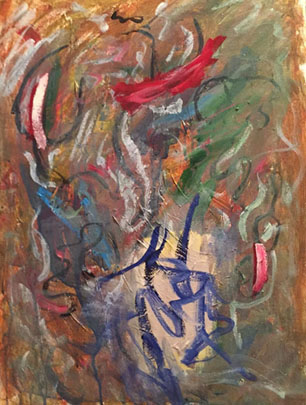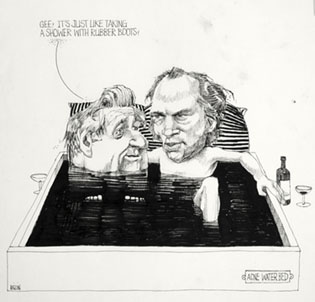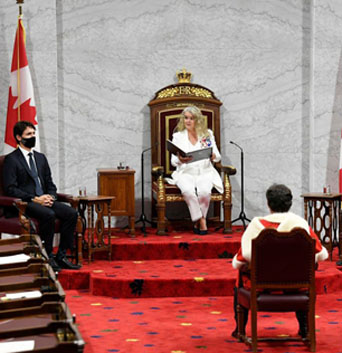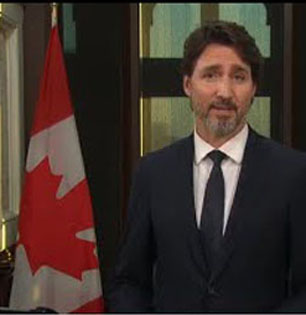So … no snap federal election in Canada this fall (Trudeau & Singh 2020—?? like Trudeau & Lewis, 1972—74??)
Sep 26th, 2020 | By Counterweights Editors | Category: In Brief
FROM THE DESKTOPS OF THE COUNTERWEIGHTS EDITORS. GANATSEKWYAGON, ON. SATURDAY, SEPTEMBER 26, 2020, 4:00 PM ET : We have to confess that some of us actually fell vaguely asleep trying to watch the much-anticipated Trudeau Liberal throne speech, on TV this past Wednesday afternoon.
The close-to-an-hour presentation by Governor General Julie Payette in alternating French and English wasn’t the kind of political oratory that grabs your attention. It was easy enough to see why PM Justin Trudeau wanted to present his own 15-minute TV summary at 6:30 PM ET Wednesday evening.
Still later again on Wednesday evening some of us did connect with the 34-page text of the Governor General’s September 23, 2020 speech, entitled A Stronger and More Resilient Canada. (And complete with a cover photo of a young girl watching the sun rise over some northern lake.)
Even in just one official language this long document itself is quite dense, though still at the general level characteristic of throne speeches in the “Westminster” tradition. The details began to appear Thursday morning with the introduction of initial implementing legislation in the Canadian House of Commons in Ottawa (COVID-19 pandemic edition).
It does nonetheless seem possible to sketch the main thrust of the Governor General’s remarks quickly, and then briefly summarize just where the political reception to what it proposes stands.
(Or, more exactly, after the election last fall the Trudeau Liberals command the plurality but not a working majority of seats in the House. If at least one of the three major opposition parties supports the broad policy vision sketched in their throne speech, the Liberal minority government will have a majority and can carry on. If not, the government will soon be defeated in the House on a matter of confidence. Then the Governor General will ask the people to choose another government in a fresh election. This is our version of democracy at work. And the ultimate question is : Will we be having a fall pandemic election in Canada, along with everything else?)
To sketch the main thrust of the Governor General’s remarks quickly, there are four “foundations” of the Trudeau Liberal plan for combatting the current coronavirus pandemic and beyond : (1) “Protecting Canadians from COVID-19” ; (2) “Helping Canadians Through the Pandemic” ; (3) “Building Back Better – a resiliency agenda for the middle class” ; and (4) “The Canada We’re Fighting For.”
For further discussion under these headings consult the 34-page text. (More of us should actually read these things. In theory at least it would improve our public debate.)
To quickly summarize the political reception in Ottawa, some language at the start of the second foundation – “Helping Canadians Through the Pandemic” – captures the crucial fault line of conflict raised by the throne speech : “This is not the time for austerity. Canada entered this crisis in the best fiscal position of its peers. And the Government is using that fiscal firepower… so that Canadians, businesses, and our entire economy have the support needed to weather the storm … Canadians should not have to take on debt that their government can better shoulder.”
Erin O’Toole’s Conservatives made their unwillingness to support this kind of continued high-government-spending policy clear from the start. From a different ideological angle, Bloc Québécois leader Yves-François Blanchet indicated that his party would not support the throne speech, “unless Trudeau commits within a week to giving the provinces $28 billion more each year in health-care transfers” – a key demand of the Quebec (and Ontario and other) provincial governments. (It is not part of the story that both M. Blanchet and Mr. O’Toole have also unhappily tested positive for COVID-19!)
On the other hand, the September 23 Liberal throne speech leans far too much on the progressive role of government to be finally voted down in good conscience by Jagmeet Singh’s progressive New Democrats. To ice the cake, in the immediate wake of the speech the Trudeau Liberals “increased the income supports in the program that will replace the CERB, a key demand of the NDP,” and then ultimately boosted “the number of people who can access sick days” (another key New Democrat demand).

As reported by CBC News on Friday afternoon (September 25) this has cleared “the way for New Democrats to support the throne speech and bypass an immediate fall election.”
On a very last historical note, PM Justin Trudeau after his second, minority-government election in 2019 is now in an intriguingly similar position to his father Pierre Trudeau’s second minority-government election in 1972.
The support of David Lewis’s NDP for the Pierre Trudeau Liberals in 1972 lasted until 1974 – at which point a fresh election finally ushered in another Pierre Trudeau Liberal majority government.
We will have to wait and see whether something similar also becomes the fate of both the Justin Trudeau Liberals and the Jagmeet Singh New Democrats, not quite half a century later!




